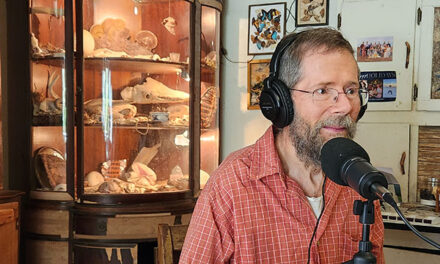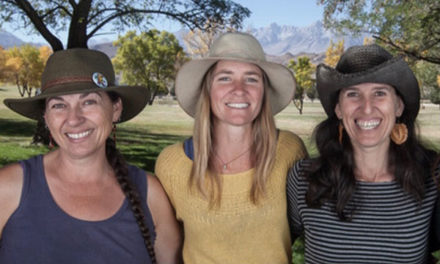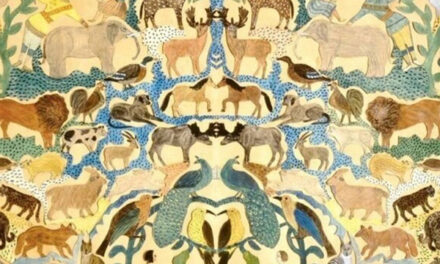Recorded March 30, 2023, released July 24, 2023
Transcript Available
Featuring: Doug Elliott and Lia Grippo
Synopsis
In this podcast, early childhood educator Lia Grippo interviews storyteller Doug Elliott about his storytelling process. As an example, he shares the background for each of the verses from his iconic story song about the black snake eating the plastic egg.
Enjoy the podcast, and please consider a donation to support our work.
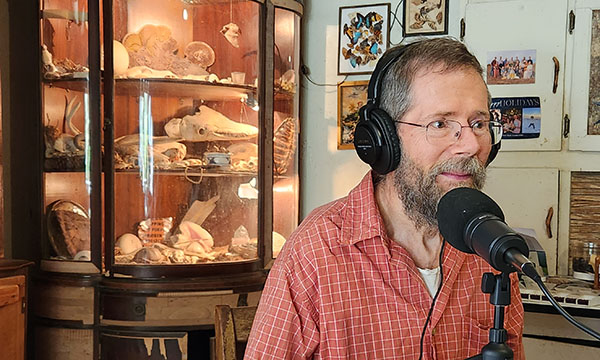
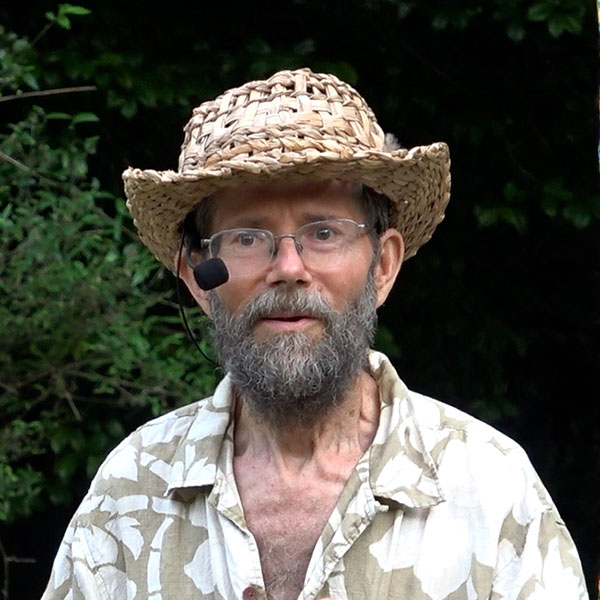
Doug Elliott
Storyteller, Faculty
Doug Elliott is a naturalist, herbalist, storyteller, basket maker, back-country guide, philosopher, and harmonica wizard. He has spent a great deal of time with traditional country folk and indigenous people, learning their stories, folklore and traditional ways of relating to the natural world. In recent years, he has performed and presented programs at festivals, museums, botanical gardens, nature centers and schools from Canada to the Caribbean.
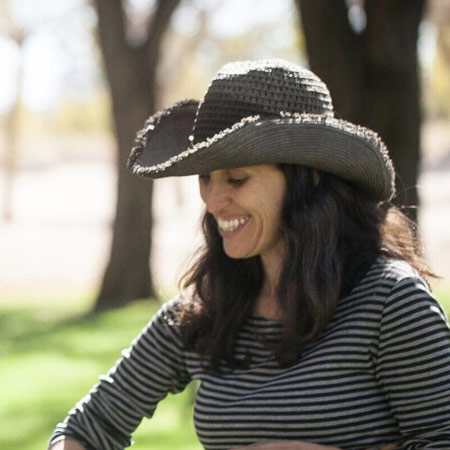
Lia Grippo
Reclaiming Nature Connection Conference Faculty
Lia is a storyteller, naturalist, herbalist, parent educator, mentor, and education consultant. Using the arts of storytelling, song, poetry, movement, and play, Lia is dedicated to helping children and families develop their powers of imagination, and through these powers, discover their relationship with all of life. Lia is a co-founder and co-director of the Academy of Forest Kindergarten Teachers, which offers formal training for forest kindergarten teachers, and the founder and director of Wild Roots Forest School, a preschool and kindergarten roofed by the sky and carpeted with the living woodland floor.
Upcoming and Recent SOIL Programs
All
Podcast Transcript
When we were keeping the chickens, catch the snakes, sometimes I’d keep it for a while. And then if I had a school program or something like that, I’d bring it and let the kids play with the snake. So I would say the snakes are getting jail time and community service for eating our eggs.
In today’s episode, early childhood educator Leah Grippo talks with storyteller Doug Elliott about his storytelling process.
Thank you, Doug Elliott, for joining us today. You’re welcome. I’m very grateful to sit in conversation with you. I wondered if we might just begin by you telling us, if you would, what’s the first story you ever remember being told?
My dad used to work regular hours. My mom was a full-time home person, and she would do things with me and my brother. We’d go to the beach, or we’d go walking here, or we’d go to the store, or whatever. And then my dad would come back and when he’d come home, they’d have a little talk about what they did that day. And then when it came time to settle me down, he’d go, here’s a story about the little boy who lived in Round Bay. That was the name of the community. And he would just take off on all the things that we did, run that through again. And so I guess that is probably some of the first stories, not a particular story, that I remember. But I did that with my son and that was always fun.
Your father would run through the story of your day with you.
Right. I was a little boy who lived in this community.
And I imagine, you can correct me if I’m wrong, but I imagine that for him also, that was a way of connecting with the separation of the day where he’s working away from home.
I guess so.
Yeah. How lovely. Do you remember as a child, did you know that those stories were about you, or did you have the feeling of, oh, I did that too.
I think I was little enough, I don’t actually remember the stories, so I just think it just was engaging.
I noticed when I had a little boy, I noticed that a narrative could pull him out of the temper tantrums or fits and like, did you hear? And then start telling a story and he had to quiet down to hear it.
Don’t we all have to quiet down to hear it?
That’s right. Life hadn’t changed that much.
Yeah, right. And were there other people in your life, other than your father, that you recall telling you stories?
Well, I mean, basically we all tell stories. We all tell about what we did. And that’s basically that makes our whole sense of reality. So in some ways, anything anybody tells you is basically a story, if they were telling something they did.
So you feel like you were surrounded by stories all the time because you were surrounded by people?
I think we all are. Yeah.
I think that’s true, too. Yes, we tell stories all the time. Do you remember the first story that you ever told with the recognition that I’m telling a story, a tale?
More in my adult life, I guess, realizing I would tell various stories in an accent. I remember Barbara Freeman and Connie Reagan Blake. They were one of the first storytellers that became public as a stage event. And they were traveling around and they kept saying, You’re a storyteller. And I was like, Oh, I guess I am.
How many years would you say you would consider yourself having been a storyteller at this point?
I guess we’re getting on 40 years anyway.
I imagine in that time, myself telling stories now and again, imagine in that time, the stories themselves have taught you a thing or two from the telling. Do you find that when you’re telling a story over and over again, that you learn something new in the story as you tell it?
Maybe about the crafting of the story and what story is ready for what audience and what way do you tell it to make it fit for the audience.
How do you feel that? Do you know what that process is? Do you name it? Name that process?
I think just watching the audience. And sometimes I’ll get together with some other storytellers and we’ll actually work on crafting our thing. What works for you about this? Here’s what I’m thinking about. And then tell the story, did that work?
One of the things I’ve been thinking about a lot recently is how ancient this craft is of storytelling and how it’s one of our oldest technologies for passing information on from generation to generation, possibly even for a generation we may never meet. I think so much about how so often the answers are all out there and we’re looking for the questions. Right. And so often when I’m listening to you tell stories, I hear and I see in my mind’s eye someone who’s willing to let themselves step into a state of innocence in order to see the world as it is. I wonder if you see yourself that way at all in storytelling.
I think if there was a formula to what I do storytelling wise, a lot of times it’s basically an incident, an encounter, a problem, or a question. You know what I saw? This thing did this, this, this, this. Well, you know what I found out? Because they do this when this happens. And I talked to an old Native American guy, and he told me that they always believe this is blah, blah, blah, blah. And then I went and looked in the books and I found this out. And so actually my story ends up becoming basically a narrative about my investigative journey. And as far as teaching material, that’s a great way to go because you portray yourself as innocent and ignorant, and we’re all innocent and ignorant about certain things. And so it helps you bond with the audience.
I found also that in so many of the old stories that get passed down over and over again. The one who can solve the really complex problems is usually the fool, the one who gets called the simpleton, right? The one who comes with innocence. And I see that. I see that in how you position yourself in your stories. I love hearing you say that everybody can relate to that. We all can, right? Stepping into the place of the unknown or stepping into the place of the wow, I wonder. And I find so much of that in your storytelling as well. So I wonder, do you ever find yourself going out and hunting for stories? Or is it really that in your daily life’s adventures, you’re catching them?
I think it’s the second more. I’m always thinking of, oh, that could make a story. Some particular incident, encounter, a problem or a question. A lot of these stories just sit around on the back burner for decades sometimes. And all of a sudden a new piece will come along, Oh, that’s perfect. That’ll finish it up right. I always like the Joseph Campbell stuff talking about basically, I guess his philosophy is that basically there’s only one story. It’s basically the hero’s journey. It’s what we’re all on every day. We wake up in the morning, we come out of the void and we live our life. And then in our lifetime, we’re born and then we come out of the void and we go back into the void again. And whatever happens in between is the journey. And that’s what we’re all involved in. And he divides it up into lots of different parts. And one of the parts is the call to adventure, where he says that you just got to discover it and I paraphrase it a little bit, ripples on the surface of life that reveals hidden springs as deep as the soul itself.
Whoa, there we go. What does that mean, that little thing? And how can we learn from it? And what does it teach us?
Lovely. We have to be paying attention in order to have that moment of, Whoa, look at that.
Was it Mary Oliver that said, instructions for living a life: pay attention, be astounded, tell about it. There it is. That’s it. Right there.
When you’re storytelling with a group of children, how do you find that you, as a storyteller, change what you’re doing?
I just try to talk to them from their perspective, I guess. Tell stories that I think that they would relate to.
You feel like there’s anything in your telling that changes when you’re with a group of children versus a group of adults?
Oh, sure. Particularly the content.
In what ways would you say that content, is it something children might directly have experienced themselves? Is it a simpler question? Is it more of the comedic?
Well, I always try to put humor in about everything. I can’t say there’s a particular way that I change. Some of the material might actually be the same, but it may be just played a little simpler or slower just to make sure they catch up with it.
There’s a story that you told once that I happened to hear that involved a snake eating a plastic egg. Right. Which to this day, I just love, love, love, love. The part of that story where you come home and get told, No, you have to take responsibility for this. You have to go solve this problem. But also the imagery of you helping that snake push that plastic egg out to me has really, really stuck with me.
It was an extraordinary adventure. And in some ways, that’s probably my figurehead story. Probably, if I have one story that people remember, that’s one. Just because it really happened and it’s so visual. So that particular story just led on to one thing after another. And I ended up writing a little song about it. And it starts with, There’s a big black snake. He’s crawling across my yard. Big black snake. He’s crawling across my yard. He may be moving slow, but Lord, he’s working hard. He’s a slippin’ and a slidin’, slippin’ and your part, slippin’ and a slidin’. Slipping and your part. Slipping and a sliding. Slipping and a sliding. Weaving and a gliding. Weaving and a gliding. Creeping and a crawling. Creeping and a crawling. Lord it’s really hauling. Lord it’s really hauling. That big black snake, he’s crawling across my yard.
And then I realized all these little incidents happened. The first thing was this snake, of course, eating the egg. But after that plastic egg incident, we stopped using a plastic egg and we needed a nest egg. And if we need a nest egg, we leave a real egg in the nest. But the problem is if snakes in the summertime come in, you got to eat them. And then we had our chickens were being free range. One time we had this settin’ hand. And a settin’ hen is a hen that once she decides she wants to sit on the nest and raise babies, she won’t hardly ever leave that nest. You almost can’t get her out of the nest. And one day we come out there and we look and she’s dead. What’s this? This dead head laying there. We looked and all her feathers on her head and her neck were all sticky looking, kind of ruffled. And we realized that what happened, she wouldn’t leave the nest. That snake came in, said, this smells like bird. I eat birds. Probably constricted her, probably strangled her right there. Started swallowing her head. Got to her shoulder, she realized it couldn’t work.
So then the verse comes, with that big black snake he mess with my settin’ hen. Big black snake he mess with my settin’ hen. I run him off, but Lord, he’s back again. One of my neighbors was pointing out to me he had Martin gourds, which is the gourds, they put them up on poles and then they had colonial nesters. Well, look, Martin’s didn’t come that year, but a bluebird did. And he went out there one morning and there was a black snake that had crawl up a two inch pole 30 feet up in the air and were eating those blue birds. What was he mad? This thing is that good a climber that it could climb up a smooth pole. Well, that big black snake he’s hanging there in my tree. Well, that big black snake just hanging in my tree. I’m watching him, but Lord, he’s watching me. He’s slippin’ and a slidin’. Slippin’ and a slidin’. Weavin’ and a glidein’. Weavin’ and a glidin’. Creepin’ and a crawlingin’. Creepin’ and a crawling.
Lord he’s really hauling. Lord is really hauling. That big black snake, he’s crawling across my yard. Well, we started free rangeing our hens. We realized it was easier to keep hens out of a garden than in a pen. And so we dispensed the garden, let the chickens run all around the yard. And there was a little shed out there, we have square bails of hay. I separated the square bails of hay, so there was a little space, so they had little nesting places. But of course, being free range like that, you got to check on them regularly. And in the summertime, it’s like we go out there and there’s a snake trying to swallow it. Darn it, those eggs. You’re supposed to be out there eating voles in the garden and rats and mice. Not our eggs. Those are our eggs. Give me that egg. I’d take the snake out and we put it in the garden. And it’s amazing. You take a five foot snake and put it down and there’s one little hole in the garden and it just disappears. Realize the voles have this whole network underground there.
One day I come out there and there she is. It’s this not very large black rat snake. And she’s working on this egg. And she is working so hard. And she’s stretched out to her max, trying to get this egg down her throat. I think, Oh, all right, you can have the egg, but I’m waiting here till you’re finished and I’m taking you out to the garden. I’m waiting, and she’s struggling, trying to get this egg down her thing. I’m waiting, I’m waiting. All of a sudden, out of the back of the hay bails comes this other much bigger black rat snake. Starts following every contour of her body. Starts vibrating his belly. And next thing you know, there are two cloakas, that multi purpose opening at the base of their tail. Were locked together and time stood still as they rolled together there in the hay. Meanwhile, she’s still trying to swallow this egg. Finally, I guess he’d done what he’d come to do if you know what I mean. And he gave her a few fond flickers of his tongue and off he went. And finally, finally, she gets that egg into position and she can roll it, rolls her body and you hear the egg go crack.
And she finally finished that egg. And she looked up and it’s hard to read the expression on the snake, but you wonder what gave her more satisfaction. But then I wrote one more verse. It goes like this.
Well, that big black snake he’s really on the make. That big black snake, he’s really on the make. I saw a fresh laid egg get swallowed by a fresh laid snake. He’s a slippin’ and a slidein’. Slippin’ and a slidein’. Weavin’ and a gliden’. Weaven and a glidein’. He’s a creepin’ and a crawling. He’s creeping and a crawling. Lord, he’s really haulin’. Lord, he’s really haulin’. That big black snake, he’s crawling across my yard.
I learned an important thing about that. They always say females are better at multitasking. Now I believe it.
Thank you for that.
Well, it took years to build that up. every little thing I got to add to it.
Stories, they’re living beings. They change and they grow just like the rest of us. I guess that’s true. Do you sit and watch the rat snakes often?
Often. Yeah.
And that’s just in the course of daily living, right? Because they’re here with you, living with you.
Right. And we keep some snake boards around with boards that are lifted up off of the ground just a little bit to give the snake room places to hang out. It’s a way of monitoring if we have copperheads in the area, but also a way of giving them shelter and always handy. When we were keeping the chickens, they would catch them in there. I’d catch the snakes sometimes I’d keep it for a while. And then if I had a school program or something like that, I’d bring it and let the kids play with the snake. So I would say the snakes are getting jail time and community service for eating our eggs. In exchange for eating eggs. But apparently they have a thriving community, too.
Friendships, relationships. Well, at least temporary.
At least temporary.
That’s right. That’s the one day stand. I don’t know.
Having an adult child of your own at this point who’s living a full, rich, independent life and having lived through 40 years of catching stories and sharing stories. If you have any advice for those of us grappling with these questions of how to serve the young people so that we keep those connections alive with story telling.
I guess tell about your own mistakes, I guess.
That place where you played the innocent or the fool yourself, huh? Right.
I’d say you’re trying to be humorist, though, and talk about different kinds of humor. There’s a humor of power where you make fun of somebody else like an ethnic joke, and you show that you’re powerful. Power. And then there’s taboo things, like jokes about sexy, scatological things, because we’re all that way, so we identify. But you can’t really tell any of those in public. But the only time you can make fun of somebody is when you make fun of yourself. And a lot of times it’s a great way to really… Like I always tell the story about following this old mountain man around and trying to learn the plants. I couldn’t learn it. I had to learn which berries you could eat. I found these little brown berries on the ground. I couldn’t find what bush they came from. I said, What are those? He said, Those are smart berries. Don’t you know them? And I said, Will, they make you smarter? He said, Yeah, you ought to try a couple of them. I tasted one and said, It smells like deer. It tastes like deer poop. He said, See, you’re getting smarter already.
Just making fun of myself.
Thank you for your time. Thank you for talking to me. Thank you for your time.
Thank you for listening. For more information about Doug Elliott and his schedule, see his website at dougelliott.com. Leah Grippo is a co-founder of the Academy of Forest Kindergarten Teachers. You can find more about her at forestkindergartenacademy.org. Please visit our website at earthavan.org, and sign up for our newsletter so you know what’s happening at the village. This podcast is produced by the School of Integrated Living in Western North Carolina. Have a great day.

